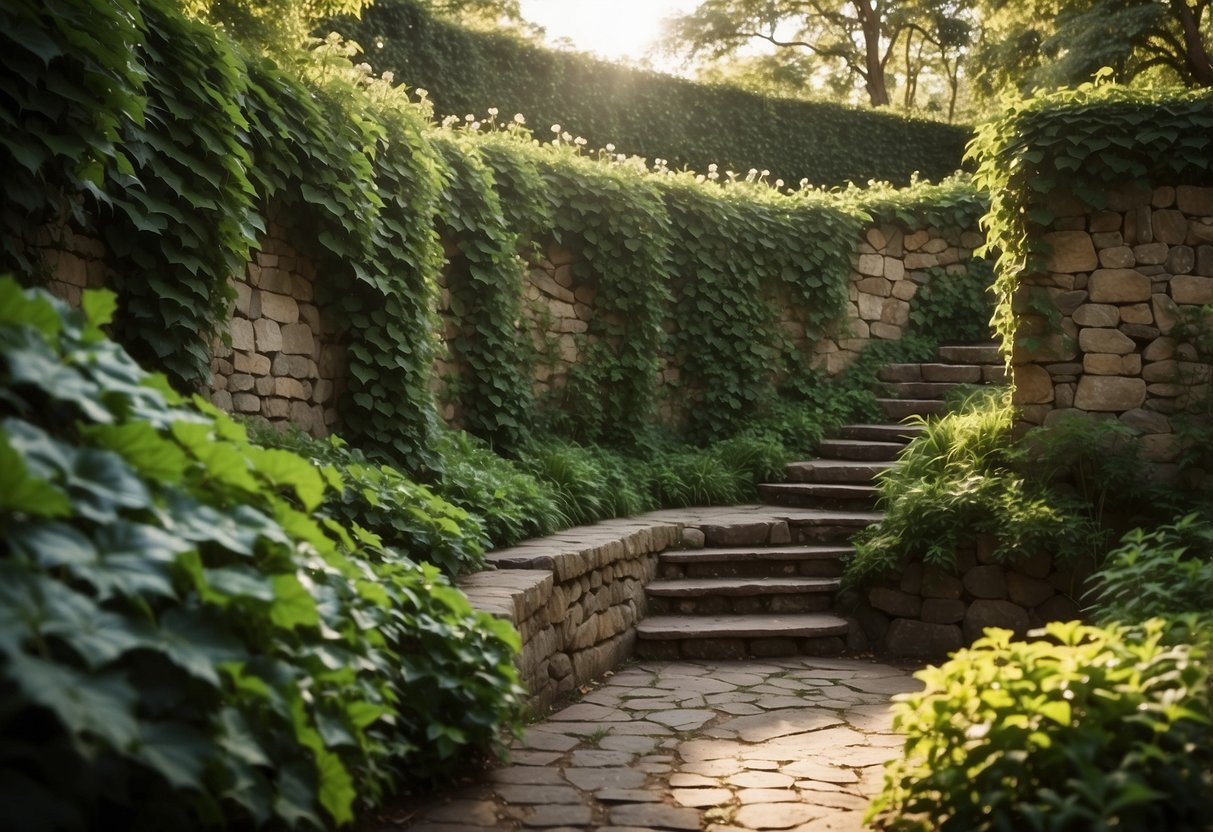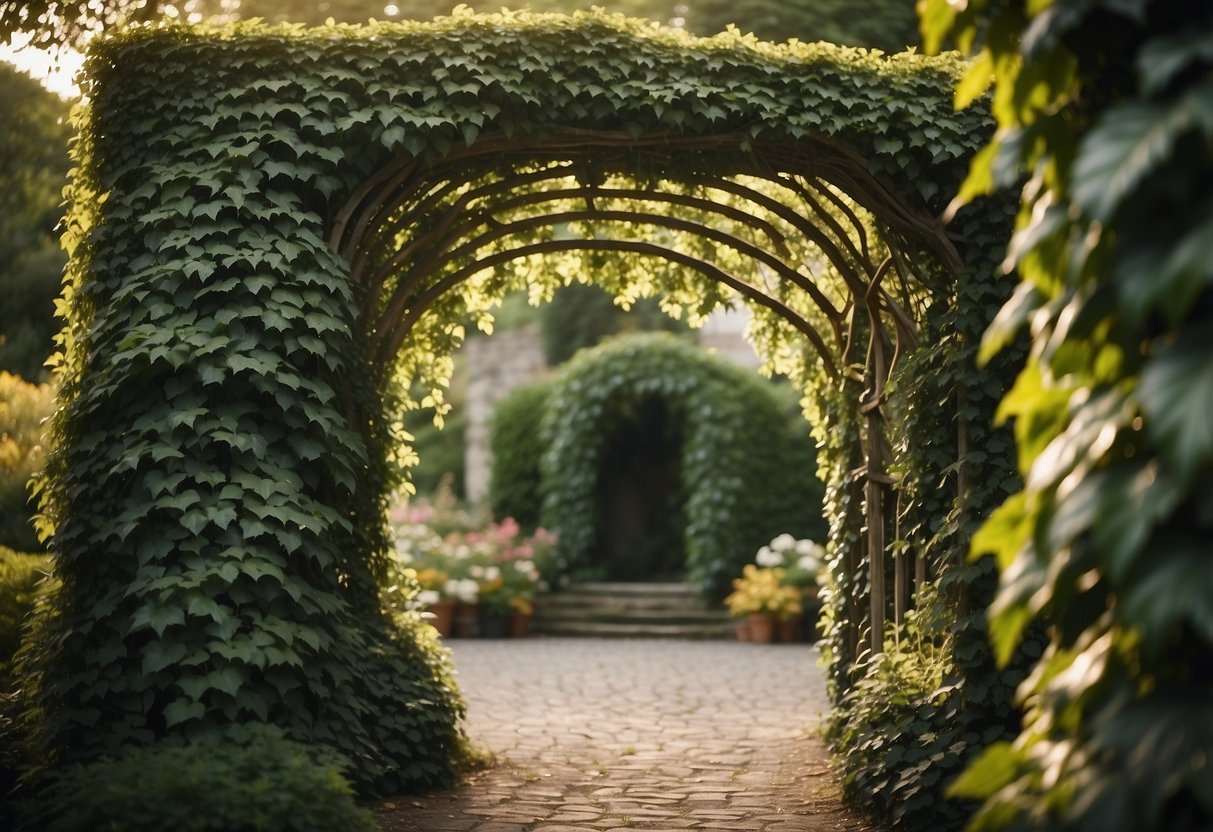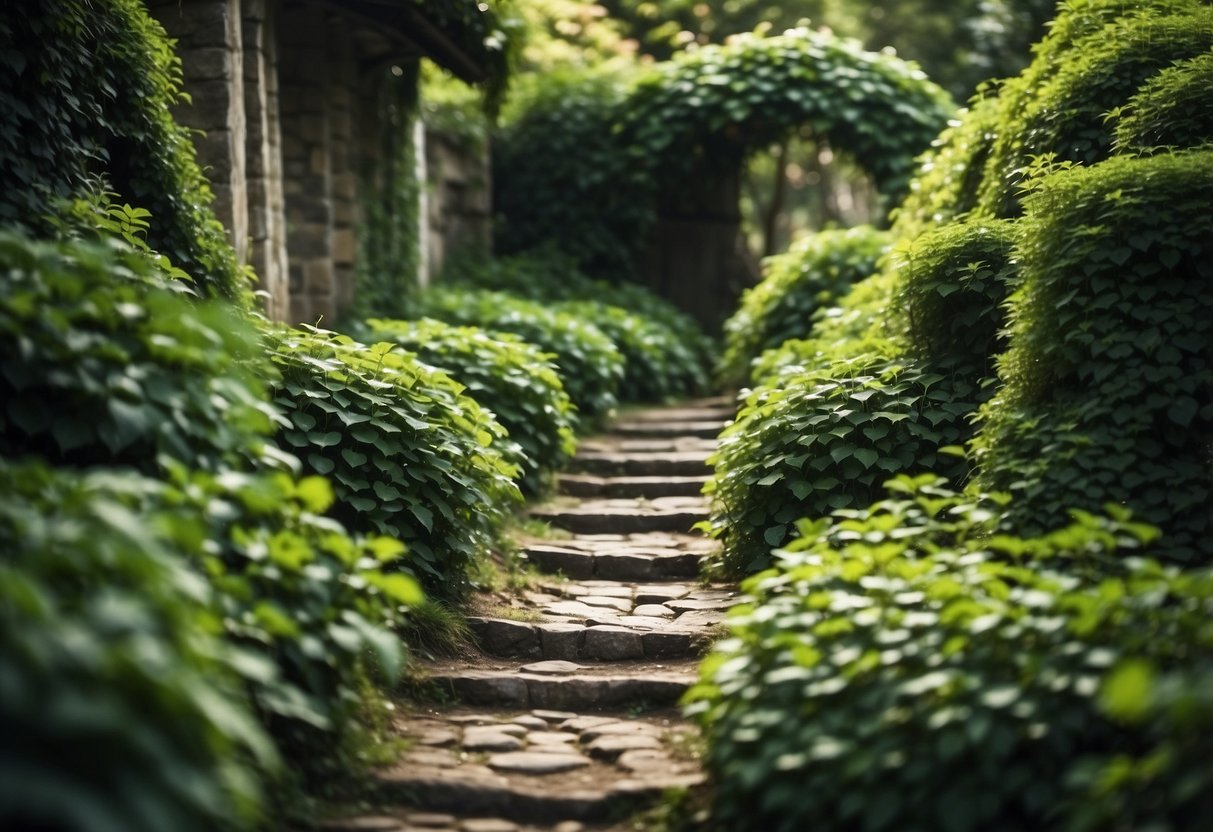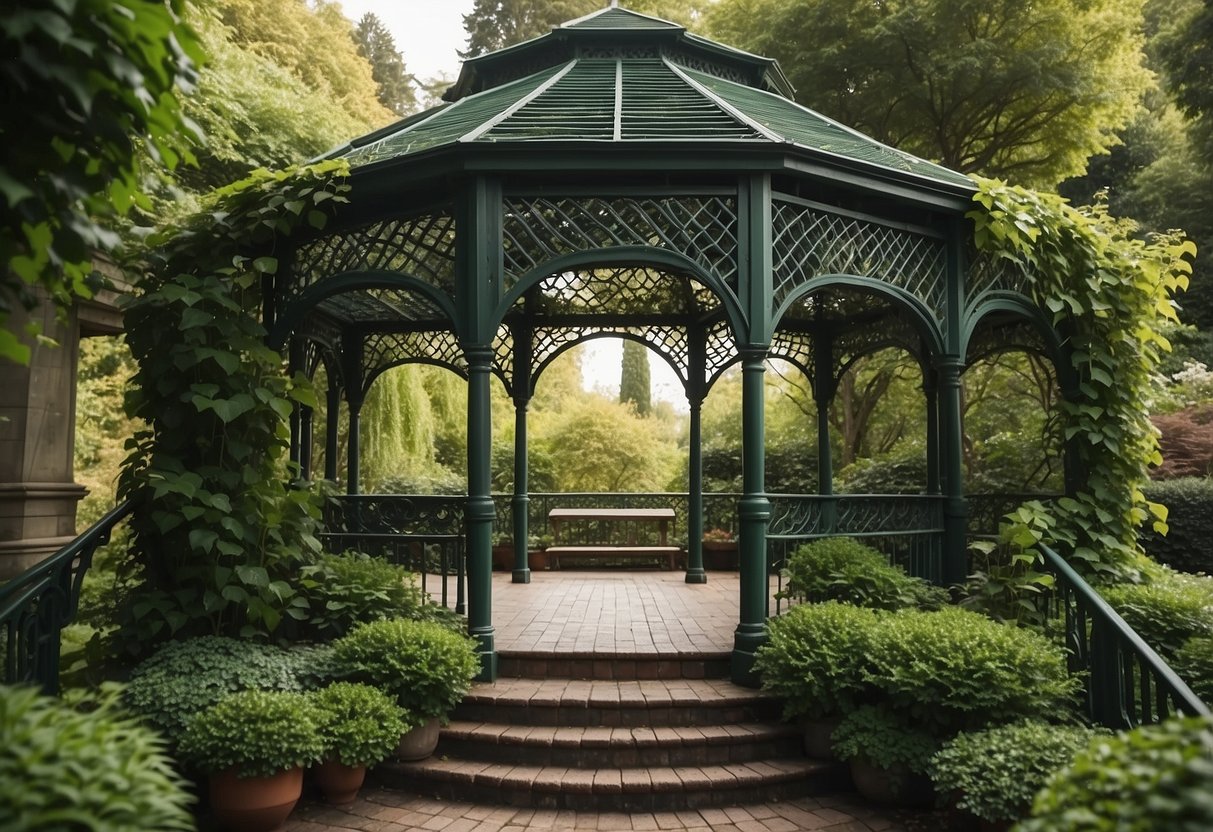Ivy Garden Ideas: Transform Your Backyard with Lush Greenery
Ivy can transform your garden into a lush, green paradise. With its fast-growing nature and versatile usage, it offers endless possibilities for garden design and decor. Whether you’re looking to create a picturesque vine-covered wall or ground cover that adds depth to your yard, ivy is a great choice.

Are you wondering how to incorporate ivy into your garden for maximum effect? From the variety of ivy species available to their different growth habits, there are plenty of options to consider. Ivy not only enhances the beauty of your outdoor space, but it’s also relatively easy to care for, making it an ideal addition for both novice and experienced gardeners alike.
1) Vertical Wall Trellis

A vertical wall trellis is a great way to add height and texture to your garden. It provides a sturdy structure for your ivy to climb and flourish.
You can choose from materials like wood, wire, or metal for your trellis. Each material can give a different look to your garden.
Placing a trellis against a wall not only supports the ivy but can also cover up an unattractive area. This way, you create a beautiful green wall that adds a natural charm to your outdoor space.
Swirling Ivy Archway

Creating a swirling ivy archway adds a magical touch to your garden.
You can start by planting ivy at the base of a sturdy archway frame. As the ivy grows, gently guide it in a spiral pattern around the frame.
This pattern not only looks beautiful but also gives your garden a whimsical and enchanting entrance.
For more tips, check out how to make a garden arch with tree branches.
3) Hanging Ivy Baskets

Hanging ivy baskets are a stylish addition to any garden. They add a touch of greenery in spaces where ground plants may not fit.
Ivy grows well in hanging baskets with well-draining soil. You can use a mix of perlite or bark to improve drainage.
Regular watering is key. Ivy baskets may need more frequent watering, especially during the hot summer months.
4) Rustic Stone Path

A rustic stone path can add a charming touch to your ivy garden. It creates a natural, textured look that blends well with greenery.
You can use cobblestones to achieve a classic rustic feel. These stones not only look great but also allow water to drain easily, protecting your plants.
For inspiration, check out these beautiful garden path ideas that showcase how to create a serene and cohesive look in your garden.
5) Bird-Friendly Ivy Arbor

Create a bird-friendly environment by incorporating ivy on your arbor. Ivy provides shelter and nesting spots for various bird species.
Add some bushes nearby for extra cover and protection. This setup attracts more birds, making your garden a lively place.
Install a bird feeder and a bird bath close to the arbor. These additions will keep birds coming back regularly.
For more inspiration, check out these ivy garden ideas. Your garden will soon be a bird paradise!
6) Ivy Clad Privacy Fence

An ivy-clad privacy fence is a charming way to enhance your garden. It provides a natural barrier that not only looks beautiful but also offers seclusion.
Ivy needs moist soil to grow properly. Water the ivy deeply once a week, especially in hot and dry weather.
Dig a hole next to the fence for each ivy plant, making sure it’s deep enough for the roots. Firmly pack the soil around the roots to keep the ivy secure.
For the best results, space smaller ivy plants about 12 inches apart. If the plants are larger, make the holes and spaces between the plants slightly bigger.
Consider choosing either English ivy or Boston ivy, both are fantastic options for a privacy fence.
More details can be found on how to plant ivy on a fence.
7) Enchanting Ivy Gazebo

Imagine a cozy spot in your garden where you can escape. An ivy-covered gazebo is just that!
The ivy climbs and covers the structure, creating a natural, green canopy. It feels like a hidden retreat.
This gazebo offers a perfect blend of shade and beauty. It’s a peaceful place to relax or enjoy a book. Add some comfy seating, and it becomes your favorite garden nook.
For more ideas, check out these garden gazebo ideas.
8) Wooden Pergola with Ivy

A wooden pergola with ivy can transform your garden into a cozy retreat. The natural wood blends seamlessly with the greenery, creating a charming and inviting atmosphere.
Ivy clinging to the pergola provides shade and adds character. Over time, the ivy will intertwine with the wood, giving it a lived-in look.
Such a setup is great for outdoor dining or simply relaxing with a book. You can see beautiful examples like those in DecorPad’s designs.
9) Garden Bench Accent

Adding a garden bench is a fantastic way to accent your ivy garden.
Imagine sitting on a beautifully designed cast iron bench while surrounded by cascading ivy. This creates a peaceful retreat where you can relax and enjoy nature.
Consider a modern bench with storage hidden underneath. This type of bench offers both style and practicality.
For a rustic touch, try a wheelbarrow-style bench. This creative design will make your garden unique and charming.
Your ivy garden will feel complete with a well-chosen bench.
10) Ivy and Fairy Light Combo

Create a magical garden by combining ivy and fairy lights. Drape fairy lights along the vines to add a warm glow.
Use the lights to highlight specific areas or create a twinkling backdrop.
Choose battery-powered or solar fairy lights for easy installation and eco-friendliness. This combination can transform any space into a cozy retreat.
For more ideas, check out this creative combination of fake ivy and fairy lights.
Choosing the Right Ivy for Your Garden

When choosing ivy for your garden, it’s important to understand the different varieties and how they match your local climate. Some ivies thrive in certain conditions better than others, so selecting the right type can make a big difference.
Understanding Different Ivy Varieties
There are many types of ivy, each with unique characteristics. English Ivy (Hedera helix) is one of the most popular choices. It is hardy and can grow in many soil types, making it versatile.
Baltic Ivy, also known as Algerian or California ivy, is another great choice. It can thrive in different soils, including sandy, clay, and neutral soils. This ivy is known for its resilience in a wide range of climates.
Boston Ivy is different since it is a deciduous vine. This means it loses its leaves in winter but provides stunning red foliage in the fall. Boston Ivy is less aggressive in its growth compared to English Ivy, making it suitable for more controlled environments.
Persian Ivy (Hedera colchica) is another lovely option. This ivy is robust and provides excellent ground cover with its dense, variegated leaves.
Climate Considerations
When selecting ivy, consider your region’s climate. English Ivy thrives in USDA zones 4 through 9. It can handle colder climates and shaded areas, making it perfect for northern gardens.
Baltic Ivy also adjusts well to various climates, growing comfortably from zones 4 to 10. This makes it a good candidate for both cool and warm areas.
If you’re in a region with harsh winters, Boston Ivy might not be ideal since it’s deciduous and loses its leaves. It does, however, perform beautifully in regions with mild winters and striking autumns.
In warmer climates, Persian Ivy can be particularly effective. It handles heat well and stays vibrant throughout the year.
By matching the ivy variety to your garden’s climate and soil type, you can create a lush, thriving garden space. Picking the right ivy makes all the difference in how well your plants will grow and enhance your outdoor area.
Designing Your Ivy Garden

Designing an ivy garden lets you create a lush and serene outdoor space. You can use ivy in various ways such as vertical green walls, combining it with other plants, and as ground cover.
Creating Vertical Green Walls
Vertical ivy walls add height and visual interest to your garden. They are perfect for small spaces where horizontal garden space is limited. Start by choosing a sturdy wall or fence. Attach a trellis or support system to guide the ivy as it climbs.
Consider varieties like English ivy or Boston ivy, which are well-suited for creating dense, green vertical surfaces. Plant the ivy at the base of the structure and water regularly. Prune the vines to encourage even growth and shape the wall as needed. Vertical ivy can also reduce noise and provide a natural privacy screen.
Combining Ivy with Other Plants
Ivy can complement other plants in your garden beautifully. Pairing ivy with colorful flowers like hydrangeas or petunias creates a striking contrast. You can also blend ivy with shrubs to add depth and texture to your garden beds.
Plant ivy near other plants that have similar sunlight and water needs. This ensures that all your plants thrive together without competition. Ivy can be trained to weave through other plants, creating a layered effect that adds beauty and interest throughout the year.
Consider using planter boxes or containers to combine ivy with perennials or annuals. This setup gives you the flexibility to rearrange and update your garden seasonally.
Using Ivy as Ground Cover
Ivy is an excellent choice for ground cover, especially in shady areas where other plants may struggle to grow. It helps prevent soil erosion and keeps weeds at bay. When planting ivy as ground cover, space the plants about one foot apart to allow them room to spread.
Ivy varieties like English ivy or Algerian ivy work well for covering large areas quickly. Keep the soil moist but well-drained, especially as the ivy establishes itself. Regular trimming will help maintain a tidy appearance and prevent the ivy from becoming invasive.
Incorporate landmarks like rocks or garden ornaments into the ivy-covered ground for added visual interest without disrupting the growth pattern. This gives your garden a cohesive and designed look.
Caring for Your Ivy

Ivy plants are quite resilient but need specific care to thrive. Key areas to focus on include regular pruning and effectively managing pests and diseases.
Pruning and Maintenance
Regular pruning helps your ivy stay healthy and prevents it from becoming too unruly. Trim back the stems whenever they start to grow beyond the desired area. Use clean, sharp scissors or pruning shears to avoid damaging the plant.
Watering is crucial. Make sure to water the ivy often, preferably when the soil is 25-50% dry. This keeps the soil moist without waterlogging it.
Light is another important factor. Place your ivy plant in a spot with bright but indirect sunlight. This helps it grow faster and stay lush.
Pest and Disease Management
Ivy can attract pests like spider mites and aphids. Check your plant regularly for signs of these pests. If you notice any, use insecticidal soap or a mixture of water and dish soap to gently remove them.
Fungal infections can also be an issue. Ensure proper air circulation around the plant to prevent molds and mildew. If you spot any signs of infection, like yellowing leaves, trim those parts away and dispose of them properly.
Sap safety is something to watch out for. The sap of ivy plants can cause skin irritation. Always wear gloves when handling or pruning the ivy to avoid any allergic reactions.
By attending to these essential aspects, your ivy will stay healthy and continue to be a beautiful addition to your garden.







